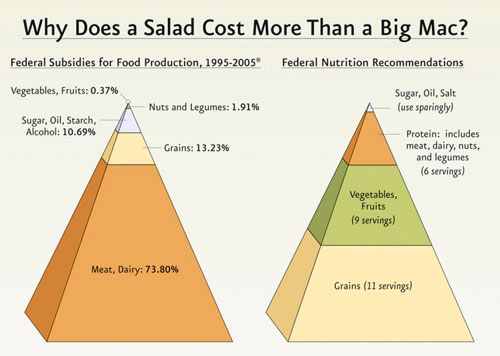
Via Economix; created by the Physicians Committee for Responsible Medicine.
If you can't view the image, it's a graphic labeled "Why Does a Salad Cost More Than a Big Mac?" featuring two pyramids. The one on the left is labeled "Federal Subsidies for Food Production, 1995-2005," and it shows the breakdown by food type of US Government Subsidies: 73.8% Meat/Dairy, 13.23% Grains, 10.69% Sugar, Oil, Starch, and Alcohol, 1.91% Nuts/Legumes, and 0.37% Fruits/Vegetables. The one of the right is labeled "Federal Nutrition Recommendations," and it shows the breakdown by food type of US Government Nutritional Guidelines: 11 servings of grains, 9 servings of fruits/vegetables, 6 servings of protein (meat, dairy, nuts, and legumes), and sugar, oil, and salt are to be "used sparingly."
The reality is that US government subsidies are almost the precise opposite of its nutritional recommendations.
The result is that shitty food is cheap. And affordable, available, easily accessible food is way more likely to be shitty food. And derivatives of highly-subsidized foods get stuck into everything, like high-fructose corn syrup, irrespective of their nutritional value.
[H/T to Shaker Naznarreb.]




Shakesville is run as a safe space. First-time commenters: Please read Shakesville's Commenting Policy and Feminism 101 Section before commenting. We also do lots of in-thread moderation, so we ask that everyone read the entirety of any thread before commenting, to ensure compliance with any in-thread moderation. Thank you.
blog comments powered by Disqus